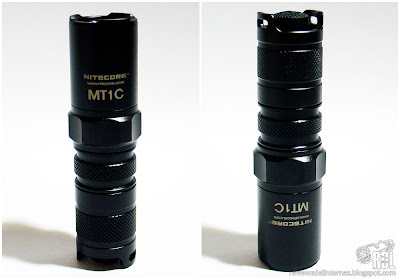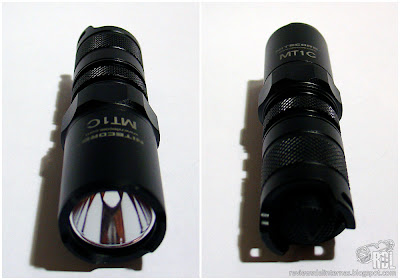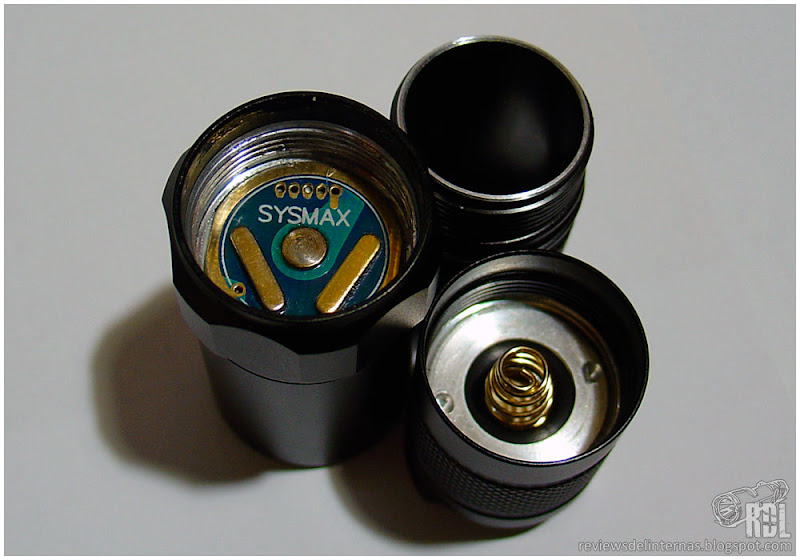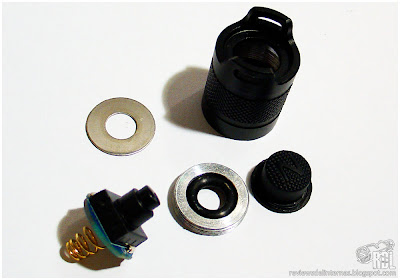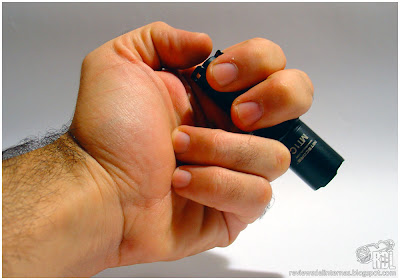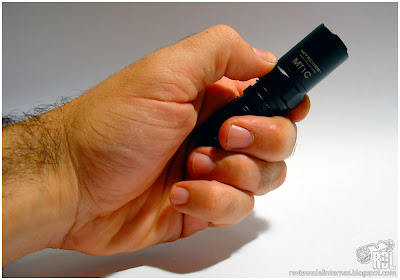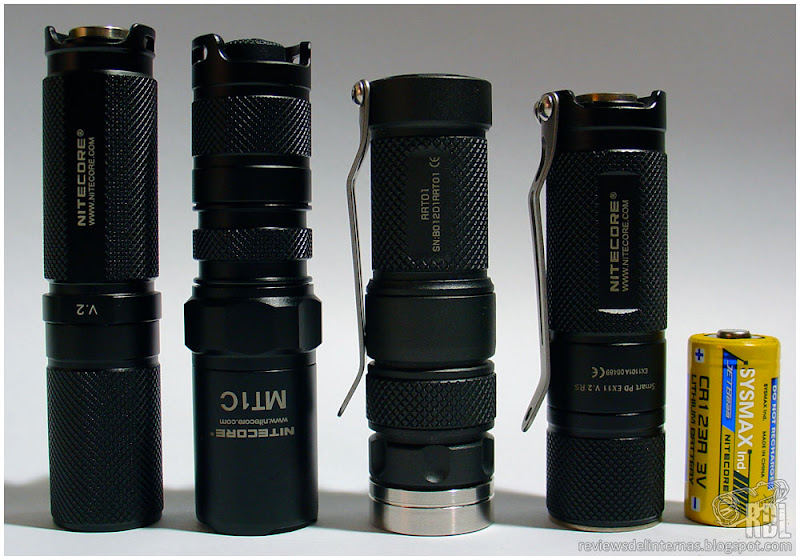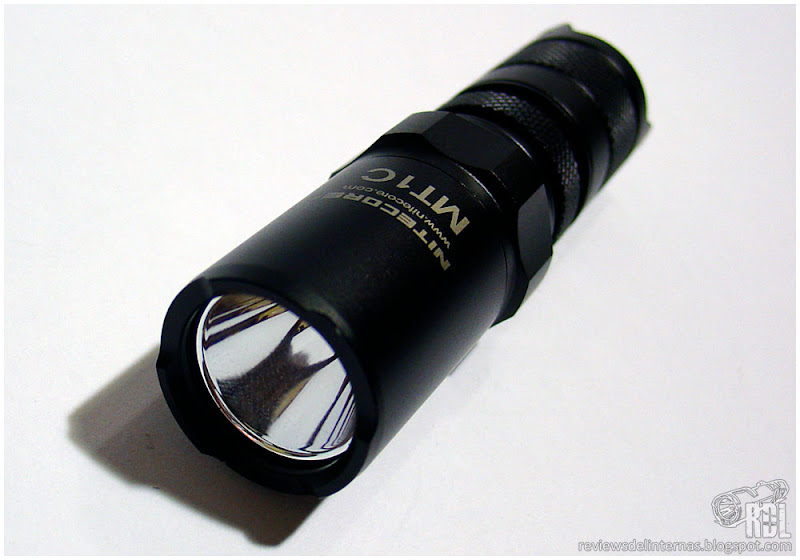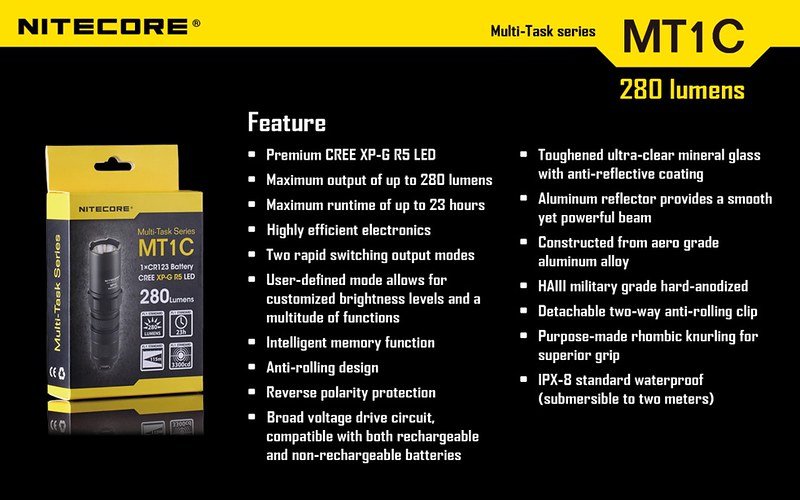NITECORE MULTI-TASK MT1C
LED:Cree XP-G R5
Battery: 1x cr123a
Modes: 6 (Turbo-High-Med-Low-SOS-Strobe)
Switch: Forward (Tailcap / Group modes selection by head twist)
Price: £33.95
Date: Oct. 2012
Links:
Nitecore.co.uk / ForoLinternas / RdL
PRESENTATION:
Nitecore has just launched its new Multi-Task range, consisting of a broad line of flashlights designed to offer multiple uses in a single tool.
The smallest of the line, is a compact flashlight, the MT1C powered by a single CR123A battery, but offering outstanding performance and amazing versatility thanks to its user interface.
Since the unit I’m reviewing it’s a review sample and came without any packaging or spares, I cannot provide pictures of the commercial package, but I can say that this flashlight comes with a set of O-rings, belt paracord lanyard, a spare tailcap silicone button and a removable titanium-plated clip, which can be installed in two directions.
EXTERIOR FINISH:
The exterior design adheres to the classic lines, with a cylindrical shape only disturbed by the hex edge of the head. Nitecore has sought a simple but practical online, virtually identical to Jetbeam P series.
The mate black anodized tone is excellent, completely uniform throughout the body of this flashlight. The logo prints are clean and superbly defined. The small knurling is perfectly machined, offering a very comfortable grip.
The head has almost smooth exterior finish, with a hexagonal ring at its junction with the body to facilitate the operation of fastening and loosening, needed to change modes between groups. The lens is anti-reflective coated glass, and behind it we have a nice smooth reflector.
The XP-G R5 LED is perfectly centered. Inside we have the circuit, which has a solid positive, and two bands that act as a shield against the installation of battery with reversed polarity.
In the small central tube, besides the aforementioned good knurling and the two tracks that will allow us to install the clip in both directions, we have the threads. Although it’s no thick finish like the one featured on the Explorer series , the machining is excellent. Furthermore the threads at the tailcap are anodized, allowing the lock-out function by loosen only a few millimeters, avoiding involuntary turn-on when we have the flashlight, for example, in a pocket.
Finally, the tailcap: inside there is housed a forward switch, also known as tactical. This allows the flashlight the momentary on function, in complete silence.
Switch is easily removable, thanks to the ring that holds it by screwing into the tailcap.
The button has a silicone coating, with a N stamped, thus customizing the classic design of these coatings.
Surrounding the button, we have two bulges in order to provide an anchor point for the wrist strap, while providing the ability to tailstand , without hindering quick access to power.
In general, we have a relatively compact design, maintaining basic lines common with the other models in the series MT.
OPERATION / UI:
The main attraction of this series lies in Multi-Task user interface. As the name suggests, Nitecore has adopted a multi-purpose system of modes to the series, halfway between the fixed and programmable modes. Thus, thanks to the two groups of modes, we can customize the user interface accordingly to the use we will give to the flashlight.
Although in the presentation I said that the torch has 6 modes, I think the easiest way to explain its interface will say that the torch has two modes:
A turbo mode, and other user selectable between 5 sub-modes available.
Among the first group, selected with the head tighten completely, we have the Turbo mode. This is fixed, providing maximum performance and we cannot change it.
In the second group, we have a user-defined mode, selectable between these five sub-modes: High, Medium, Low, SOS and Strobe (with variable frequency).
To select secondary mode, slightly loose the head of the flashlight, tap the switch until the desired mode, and full click to on. The flashlight mode memorized, and is set as secondary.
We switch between Turbo and user-defined mode by rotating slightly flashlight head.
Thus, a single lantern can meet the needs of multiple daily uses different combinations: Turbo and Low for indoor use, outdoor and Middle Turbo, Turbo and Strobe for tactical or defensive …
BATTERY LIFE & CURRENT DRAWS:
table(table#posts).
|CR123A SYSMAX @ 3V ![]()
|Turbo:|2130mA|
|High:|410mA|
|Medium:|175mA|
|Low:|40mA|

In its instruction manual is clearly stated that this flashlight is only compatible with CR123A batteries (or rechargeable with equivalent voltage), and warns that its use with Li-Ion batteries (RCR123 3.7V) is strictly prohibited.
This is a comparison between the performance of Turbo, High and Medium:

It can be seen clearly that the torch is regulated, while maintaining constant brightness in high and medium modes evenly. In Turbo mode, there is a step-down at about 3 minutes of continuous use, presumably to protect the torch from overheating. Once reduced performance, this remains stable during almost the rest of the life of the battery. This reduction appears to be controlled by time, and not termal, because we can go back to 100% turning the flashlight off and on again.
Here in detail each of the three modes analyzed:



Finally, I compared the performance between different modes MT1C, and the relative value of other two Nitecores using the same, albeit with a few more years:
This new MT1C with the same battery is capable of delivering in Turbo mode 60 lumen extras compared with the Nitecore EX11.2.
BEAM PROFILE:
Due it’s multi-purpose personality, Nitecore has endowed this MT1C with a XP-G, thus ensuring a good compromise between flood and throw. The smooth and somewhat deep reflector considering the overall size of the flashlight, gives the LED a good approach without sacrificing much spill. The hotspot fades gradually, giving the impression of having a central point larger than it actually is.

In the hotspot you can see some artifacts, especially a small dot right in the center with less intensity, but only noticeable when projecting clear and smooth surfaces nearby.
The cold white tint is really good, much better than the EX11.2 or D11 V.2 equipped with the same LED. Something completely understandable by the difference in years between the launch of two models, and improvements in the production of the XP-G during this time.
PERSONAL CONCLUSION:
This MT1C meets and exceeds the goals that the company has taken into account when designing it. A versatile flashlight with the ability to have one fixed and one personalized mode, without complicated sequence or shortcuts that can be useful in many applications, in one pocket size but with a remarkable power.
But to be honest I think Nitecore has missed a unique opportunity. They have a new line of multipurpose flashlights, and stick to well-known XP-G, right on the dates on which the second generation of this package (XP-G2) is breaking into the market, providing improved performance, efficiency and throw with an encapsulation of identical dimensions. I think that this decision is based on the reliability and consistency demonstrated by the XP-G compared to the young first generation of XP-G2.
I also note with some regret the express prohibition use with Li-Ion batteries. Presumably, this refusal is to maximize efficiency with CR123A batteries, and I must recognize that Nitecore here has done an excellent job.
Moreover, a flashlight with solid Nitecore quality, at a reasonable price.
![]() I like:
I like:
- User Interface.
- Nitecore quality.
- Versatile and compact.
![]() I do not like:
I do not like:
- 1st gen. XP-G.
- Not compatible with Li-Ion batteries.




